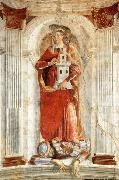Wholesale Oil Painting No Minimum |
|||||||||||
|
|
|||||||||||

|
|||||||||||
|
|
|
||||||||
Robert Campin1406-1444 Robert Campin Location South Netherlandish painter. He is first mentioned in 1405-6 as a painter in Tournai. As he purchased citizenship there in 1410, he may have been born elsewhere. There is evidence of some connection with Valenciennes, where the name Campin is said to have been common, but nothing certain is known of his artistic training and background. |
||||||||
|
|
||||||||
St Barbara
St Barbara Painting ID:: 33426 |
mk86
1438
Tempera on wood
101x47cm
Madrid,Museo del Prado
mk86 1438 Tempera on wood 101x47cm Madrid,Museo del Prado |
|||||||
|
|
||||||||
GHIRLANDAIO, DomenicoItalian Early Renaissance Painter, 1449-1494 Florentine painter, whose family name was Bigordi. He may have studied painting and mosaics under Alesso Baldovinetti. Ghirlandaio was an excellent technician. Keenly observant of the contemporary scene, he depicted many prominent Florentine personalities within his religious narrative paintings. Among his earliest frescoes are the Madonna with the Vespucci Family and the Last Supper (Church of the Ognissanti, Florence). He painted scenes from the life of Santa Fina (collegiate church in San Gimigniano) and frescoes in the Palazzo Vecchio, Florence. In 1481, Pope Sixtus IV called him to Rome, along with Botticelli, to decorate the Sistine Chapel. He painted the Calling of the First Apostles, a scene close in spirit to Masaccio. He returned to Florence to work on the frescoes in the Sassetti Chapel in Santa Trinita. He introduced Sassetti, Corsi, Poliziano, the Medici, and many other contemporaries as participants in the life of St. Francis. Ghirlandaio's most famous achievement is his fresco cycle of the life of Mary and St. John the Baptist for the choir of Santa Maria Novella. Michelangelo served an apprenticeship with him at this time and probably worked on these frescoes. Other examples of his art are the Adoration of the Magi (Uffizi); another Adoration (Hospital of the Innocents); a mosaic of the Annunciation for the Cathedral; a portrait of Francesco Sassetti and his son (Metropolitan Mus.); |
||||||||
|
|
||||||||
|
|
St Barbara
St Barbara Painting ID:: 63001 |
1471 Fresco Parish Church of Sant'Andrea, Cercina The vivid colour of her garments and the different shape of her niche give greater emphasis to the figure of St Barbara, who stands between the two old men, St Jerome and St Antony. She is holding her attribute, a tower, and in contrast to the two other saints is looking directly to us. Because she was so beautiful, Barbara's pagan father locked her in a tower. She converted to Christianity, and against his wishes built in her tower a chapel, its three windows symbolizing of the Trinity. Enraged, her father had her beheaded. Here she is depicted standing triumphantly on the armor-clad corpse of her father, who has been killed by a bolt of lightning. His hands are hanging down over the cornice, where they are casting illusory shadows. Artist: GHIRLANDAIO, Domenico Painting Title: St Barbara , 1451-1500 Painting Style: Italian , , religious 1471 Fresco Parish Church of Sant'Andrea, Cercina The vivid colour of her garments and the different shape of her niche give greater emphasis to the figure of St Barbara, who stands between the two old men, St Jerome and St Antony. She is holding her attribute, a tower, and in contrast to the two other saints is looking directly to us. Because she was so beautiful, Barbara's pagan father locked her in a tower. She converted to Christianity, and against his wishes built in her tower a chapel, its three windows symbolizing of the Trinity. Enraged, her father had her beheaded. Here she is depicted standing triumphantly on the armor-clad corpse of her father, who has been killed by a bolt of lightning. His hands are hanging down over the cornice, where they are casting illusory shadows. Artist: GHIRLANDAIO, Domenico Painting Title: St Barbara , 1451-1500 Painting Style: Italian , , religious |
||||||
|
|
||||||||
|
|
||||||||
|
|
St Barbara
St Barbara Painting ID:: 64482 |
1762 Painted and gilt wood Monastery Church, Ettal Straub created mainly elegant wooden statues, sometimes, like St Barbara, with courtly attitudes. Artist:STRAUB, Johann Baptist Title: St Barbara, 1751-1800, German , sculpture , religious 1762 Painted and gilt wood Monastery Church, Ettal Straub created mainly elegant wooden statues, sometimes, like St Barbara, with courtly attitudes. Artist:STRAUB, Johann Baptist Title: St Barbara, 1751-1800, German , sculpture , religious |
||||||
|
|
||||||||
|
unknow artist St Barbara 1762 Painted and gilt wood Monastery Church, Ettal Straub created mainly elegant wooden statues, sometimes, like St Barbara, with courtly attitudes. Artist:STRAUB, Johann Baptist Title: St Barbara, 1751-1800, German , sculpture , religious |
||||||||
|
|
||||||||
|
Prev Next
|
||||||||
|
|
||||||||
|
Related Paintings to unknow artist :. |
||||||||
|
|
||||||||
|
CONTACT US |



